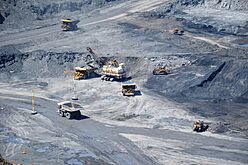Titanoboa facts for kids
Quick facts for kids Titanoboa |
|
|---|---|
 |
|
| A piece of the backbone (vertebra) from T. cerrejonensis | |
| Scientific classification | |
| Genus: |
Titanoboa
|
| Species: |
cerrejonensis
|
Titanoboa (which means "titanic boa") is a genus of giant snake that lived about 60 to 58 million years ago, during the Paleocene epoch. This was not long after the dinosaurs went extinct. This enormous snake is a relative of modern boas and anacondas.
Fossils of Titanoboa were first found in the early 2000s in the Cerrejón coal mines in northeastern Colombia. A team of students and scientists from the Smithsonian Tropical Research Institute and the University of Florida uncovered the fossils. In 2009, they named it Titanoboa cerrejonensis. For many years, it was known as the largest snake that ever lived.
Scientists first only had parts of its backbone and ribs. Later, they found pieces of its skull and teeth, which gave them more clues about how this giant predator lived. Titanoboa was likely a top predator in the ancient tropical rivers of South America.
Contents
Discovering a Giant Snake

In 2002, students on an expedition to the Cerrejón coal mines in Colombia found some very large fossils. At first, they thought the huge backbones and ribs belonged to ancient crocodiles. The team, led by Jonathon Bloch and Carlos Jaramillo, collected 186 fossils from about 30 different snakes.
The fossils were sent to the Florida Museum of Natural History for study. An international team of scientists realized these were not crocodile bones. They belonged to a new, gigantic species of snake. In 2009, they named it Titanoboa cerrejonensis. The name "Titanoboa" comes from "Titan," the giants of Greek mythology, and "Boa" for the snake family it belongs to. The species name, "cerrejonensis," honors the Cerrejón region where it was found.
Later expeditions in 2011 found even more fossils, including three skulls. Finding skulls is very rare for fossil snakes, and it helped scientists learn much more about Titanoboa. The discovery was so amazing that it was featured in a documentary called Titanoboa: Monster Snake.
What Titanoboa Was Like
How Big Was Titanoboa?

Titanoboa was the largest snake ever discovered for a long time. By studying the size of its backbone, scientists estimated it could grow up to 12.8 m (42 ft) long. Some estimates suggest it could have even reached 14.3 m (47 ft)—that's longer than a school bus!
This giant snake could have weighed between 730–1,135 kg (1,610–2,500 lb). That's as heavy as a small car or a large cow. Titanoboa was much bigger than the largest snakes alive today, the green anaconda and the reticulated python.
For years, Titanoboa held the record as the biggest snake of all time. In 2024, scientists in India described another huge prehistoric snake, Vasuki indicus. Vasuki may have been slightly longer than Titanoboa, but Titanoboa was probably heavier and more robust.
A Powerful Body and Specialized Skull
The backbone of Titanoboa was very strong and wide. The shape of its vertebrae (the bones that make up the spine) was similar to other boas, but much larger and thicker. This powerful build would have supported its massive body.
The skull of Titanoboa was also special. It had many more teeth than other boas. The teeth were not strongly attached to the jawbone. This, along with other features of its skull, suggests that Titanoboa was adapted for a specific diet, different from its modern relatives.
Titanoboa's Family Tree
Titanoboa is part of the Boidae family, which includes all boas and anacondas. These snakes are known as "constrictors" because they squeeze their prey. Scientists placed Titanoboa in a smaller group called Boinae, based on the shape of its bones.
Interestingly, the skull of Titanoboa suggests its closest living relatives are boas from Madagascar and the Pacific Islands. This is a fascinating clue for scientists. It suggests that the ancestors of these snakes spread across the world millions of years ago, back when the continents were closer together.
Life in a Prehistoric Rainforest
What Did Titanoboa Eat?
Because of its huge size, scientists first thought Titanoboa might have hunted large crocodiles that lived in the same rivers. However, after studying its skull and teeth, they changed their minds.
The skull had features perfect for a diet of fish. Its many small, thin teeth would have been great for grabbing slippery fish. The rivers where Titanoboa lived were full of large fish, including ancient lungfish. So, this giant snake was likely a specialized fish-eater, waiting in the water for its meals.
A Hot and Swampy World
Titanoboa lived in a very different world than ours. About 60 million years ago, the area of modern-day Colombia was a vast, wet tropical forest with large river systems. The climate was much hotter and more humid than it is today.
This ancient rainforest was home to many amazing creatures. Besides Titanoboa, there were giant turtles like Carbonemys (the "coal turtle") and several types of ancient crocodiles called dyrosaurs. The forest itself was filled with plants like ferns and early relatives of bananas and ginger.
A Clue to Ancient Climates
Snakes are ectothermic, or "cold-blooded," which means their body temperature depends on the temperature of their surroundings. Giant cold-blooded animals can only survive in very warm climates.
Because Titanoboa was so enormous, scientists believe the average yearly temperature in its habitat must have been around 32–33 °C (90–91 °F). This is much warmer than the average temperature in modern tropical rainforests. The discovery of Titanoboa gave scientists an important clue about how hot Earth's climate was after the extinction of the dinosaurs. While scientists still discuss the exact temperatures, Titanoboa remains a key piece of evidence for understanding ancient climates.
See also
 In Spanish: Titanoboa para niños
In Spanish: Titanoboa para niños



